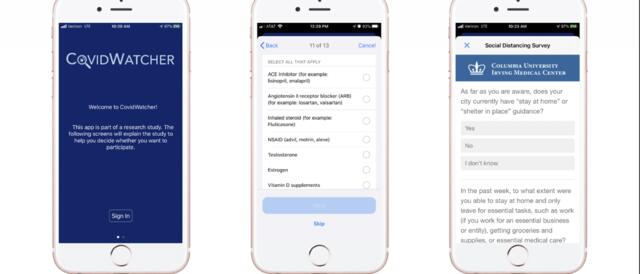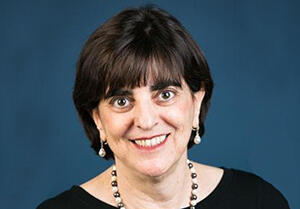
SIPA’s Ester Fuchs and USP Students Help Launch CovidWatcher

Researchers from Columbia University have launched CovidWatcher, an app and online portal that surveys users about their exposure to the new coronavirus, symptoms, access to medical care, and impact on daily life. The data will be used to track the spread of the coronavirus in New York City, giving citizens real-time information about hot spots and enabling health care officials to deploy resources where needed most.
CovidWatcher differs from other coronavirus apps and trackers because it encourages users to update their status daily or weekly, providing critical information as the pandemic continues to evolve. The app and online portal also include survey questions that allow users to report their concerns about access to education financial resources, transportation, employment and healthcare.
The project is led by Professor Noemi Elhadad and Dr. Jason Zucker of Columbia University Irving Medical Center; SIPA’s Ester R. Fuchs, a professor of international and public affairs who directs the concentration in Urban and Social Policy, is a co-investigator.
While the project’s first aim is to collect information about the virus and health conditions, Fuchs and students in SIPA’s Urban and Social Policy concentration are playing a key role in disseminating the survey, and making sure it reaches the largest number of New Yorkers.
It’s essential that the data collected through the survey is representative of the entire city, said Fuchs, with special attention to underserved communities.

“We can use this data to direct resources during the pandemic, both to the most vulnerable communities now and to those neighborhoods where we expect to see the next concentration of cases,” she said. “Later on, we can use the data to address secondary effects after the pandemic—to target resources in support of social-service needs, mental-health needs, job assistance, and more.”
Researchers will share data with a network of community partners identified by Fuchs and her students, including community organizations, faith-based institutions, not-for-profits, business associations and others.
When the pandemic subsides, Fuchs explained, such stakeholders “can be effective advocates for high-needs communities, helping us to see the human impact on New Yorkers and ensuring that responses by the government and other organizations can be targeted and effective.”
The project gives community organizations a chance to make sure they have a voice in the city’s recovery process.
“We had a great Zoom call on Friday with about 25 partners, including executive directors from many different organizations,” said Fuchs. “These are typically the most involved people, and they want to help, they want to do something that ensures high-risk populations are identified and given the resources they need to fully recover.”
Among other things, selected partners helped to refine the survey by reviewing the questions and suggesting how they would be perceived by people in their communities.
Indeed, how such survey questions are designed is important.
“A survey has to be accessible to the people you want to respond,” Fuchs said. “That means it has to be relatively short, and the respondents have to feel there’s a reason to reply. We needed to design the message so that individuals can see the importance of responding, the value for themselves and their families and neighborhoods.”
Fuchs praised the SIPA students who are assisting in the effort, in part by considering the logistics of distribution and also developing templates for social media networks including Facebook, Twitter, Instagram, and Tik Tok.
“SIPA students have been really important in helping to craft the messages and working with community partners to make sure the response rate is as high as possible,” she said.
- Read our Q&A with Andrea Greenstein MPA ’20, one of the participating students »
Such efforts are important, Fuchs said, because the researchers are relying on participants to return to the survey multiple times—now, and in a few weeks, and after the pandemic passes, and so on.
Fuchs said the survey’s holistic approach embraces the medical and scientific while remaining mindful of people’s basic needs.
“People need to pay rent and utilities, and they need to buy groceries,” she observed. “We want to ensure that people who lost their jobs have a chance to connect back to work and receive support in the interim period.”
Fuchs said the University played an important role in bringing together scholars in different areas.
“We would never have been able to do this without CUIMC, but we’re able to be a valuable partner in designing the research,” said Fuchs. “It’s a great collaboration for the University.”